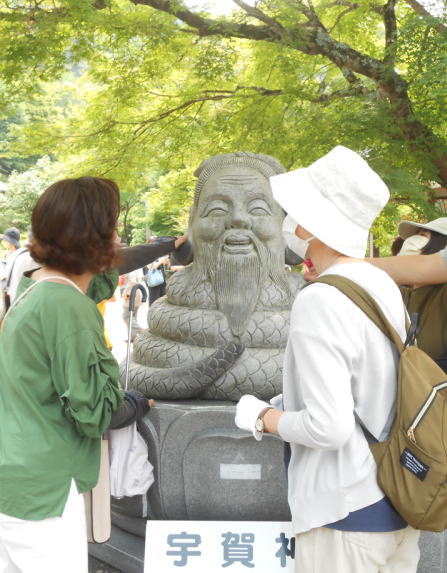Old Man, Snake, or Deity?
 Just look at the photo. What do you see? A happy old man surrounded by ladies? But look carefully. Strange, right? What shall we describe it — an old man with a snake body or a snake with a man’s head? Either way, it doesn’t seem to be someone in this world. No wonder he’s a dweller of the Japanese celestial cosmos.
Just look at the photo. What do you see? A happy old man surrounded by ladies? But look carefully. Strange, right? What shall we describe it — an old man with a snake body or a snake with a man’s head? Either way, it doesn’t seem to be someone in this world. No wonder he’s a dweller of the Japanese celestial cosmos.
Called “Uga”, he’s a deity generally believed to give people fortunes. Even though addressed by “he” here, an old man with a coiled snake body is simply one way to represent the entity. Hence, there’s a female version of the image, with a woman’s head on a serpent coil.
Exploring the origin of the deity, the name “Uga” relates to Ukano Mitama, the deification of the spirit dwelling in the rice cereal. Related to the word “Uka” or “Uke” (meaning “meal”), its manifestation is a goddess form in Japanese mythology (so, after all, it’s a female). The general idea is that Ukano Mitama is the same as Inari divinity, consecrated in many shrines such as Fushimi Inari.
OK, but still, we may wonder why a snake body? If the creature usually reminds us of something vicious and sinister, this man's innocent, benign smile and a scary coil is an unfitting combination.
To solve this puzzle, let’s consider that ancient people often deify snakes, and the custom still survives today. For instance, my father would stop my mother when she tried to abuse a white snake straying into our house, saying that white snakes were messengers of gods. Such respect for the creature exists not only in Japan but also in ancient India or Egypt. India, the origin of Buddhism, is the home to a legendary being called “Naga”, often depicted in a half-human, half-snake form and considered the same as a dragon deity. Since Buddhism and its cosmology have come to Japan via China, it’s not surprising to see many serpent gods enshrined in temples and shrines. Except their forms and profiles have changed in Japanese ways over a long passage of time.
 So let’s adequately meet the deity “Uga Jin” (Deity Uga). You can find this particular image at Mimurotoji Temple in Kyoto. A notice placed by the statue says, “Touching its ears will bring you fortunes, stroking the beard will give you health and longevity, and gently rubbing the tail, luck with money”. You can try that if you want some of them but beware: do it with reverence, gratitude, and moderation. Like Greek mythological gods, deities sometimes can be cruel if humans lack respect toward them (despite his gentle smile).
So let’s adequately meet the deity “Uga Jin” (Deity Uga). You can find this particular image at Mimurotoji Temple in Kyoto. A notice placed by the statue says, “Touching its ears will bring you fortunes, stroking the beard will give you health and longevity, and gently rubbing the tail, luck with money”. You can try that if you want some of them but beware: do it with reverence, gratitude, and moderation. Like Greek mythological gods, deities sometimes can be cruel if humans lack respect toward them (despite his gentle smile).
(N.S.)
|




